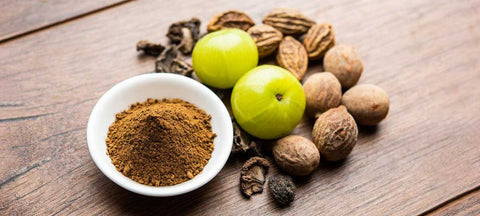Triphala, a cornerstone of Ayurvedic medicine, is a traditional herbal remedy that has been used for thousands of years to promote health and well-being. Made from the dried fruits of three medicinal plants—Amalaki, Bibhitaki, and Haritaki—Triphala is revered not only for its effective healing properties but also for its preventive capabilities. This post explores the origins, benefits, and uses of Triphala, shedding light on why it remains a popular herbal supplement in contemporary health circles.
Origins and Composition
Triphala, which literally means "three fruits" in Sanskrit, is composed of equal parts of three plant extracts:
- Amalaki (Emblica officinalis): Also known as Indian gooseberry, Amalaki is high in vitamin C and potent antioxidants, supporting immune function and skin health.
- Bibhitaki (Terminalia bellirica): Known for its rejuvenating properties, Bibhitaki promotes respiratory health and effectively supports the mucous membranes.
-
Haritaki (Terminalia chebula): Often referred to as the "king of medicine" in Tibet, Haritaki has therapeutic effects across multiple systems of the body, particularly the digestive and excretory systems.
Health Benefits of Triphala
- Digestive Health: Triphala is most commonly known for its natural laxative properties, without being habit-forming. It aids in digestion and the assimilation of nutrients while also cleansing the colon.
- Detoxification: Triphala supports the body's natural cleansing process, helping to remove toxins from the intestines and bloodstream.
- Oral Health: When used as a mouthwash, Triphala can help reduce gum inflammation and prevent the buildup of plaque, thanks to its antimicrobial properties.
- Eye Health: Triphala has been shown to support eye health, including the potential to improve vision and prevent diseases of the eye.
- Weight Management: Its ability to regulate metabolism and improve digestion makes Triphala a useful aid in weight management efforts.
-
Antioxidant Properties: The high concentration of vitamin C and other antioxidants in Triphala helps combat oxidative stress and reduce inflammation.
How to Use Triphala
- As a Supplement: Triphala is available in powder, capsule, and tablet forms. The powder can be mixed with warm water and taken before bed or on an empty stomach in the morning.
- As a Tea: Triphala tea is another popular method of consumption, especially for those looking to use it for digestive benefits.
-
Topically: For skin applications, Triphala can be made into a paste and applied to areas of inflammation or as part of a face mask to promote skin rejuvenation.
Who Should Use Triphala?
While Triphala is generally safe for most adults, it is always best to consult with a healthcare provider before starting any new supplement, especially for those who are pregnant, nursing, or have existing health conditions.
Potential Side Effects
Triphala is considered safe for long-term use in appropriate doses. However, excessive consumption can lead to gastrointestinal symptoms like diarrhea and abdominal discomfort.
Conclusion
Triphala offers a multi-dimensional approach to health, embodying the principles of Ayurvedic medicine by promoting balance and rejuvenation. Its holistic benefits make it an excellent supplement for those looking to enhance their overall health naturally. Whether you’re seeking digestive relief, detoxification, or general wellness, Triphala may be the herbal remedy worth incorporating into your health regimen.



